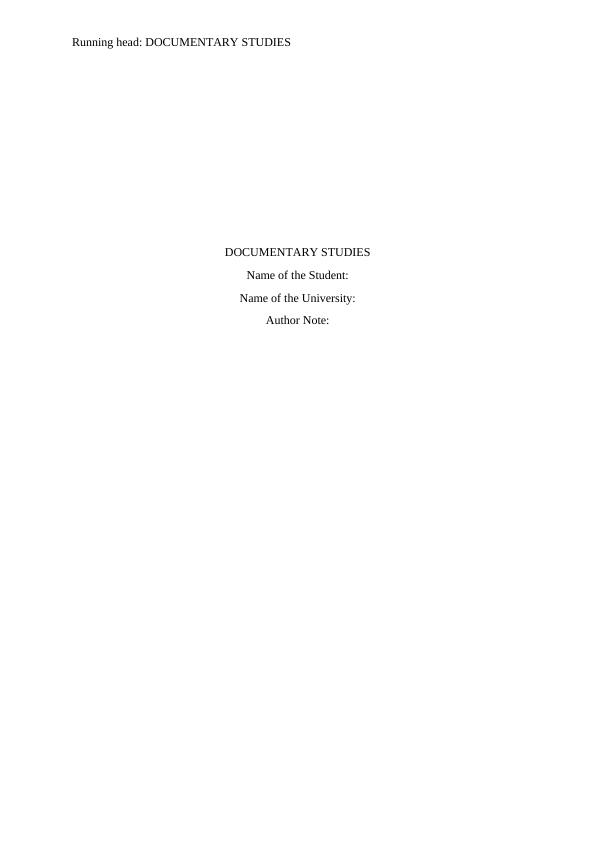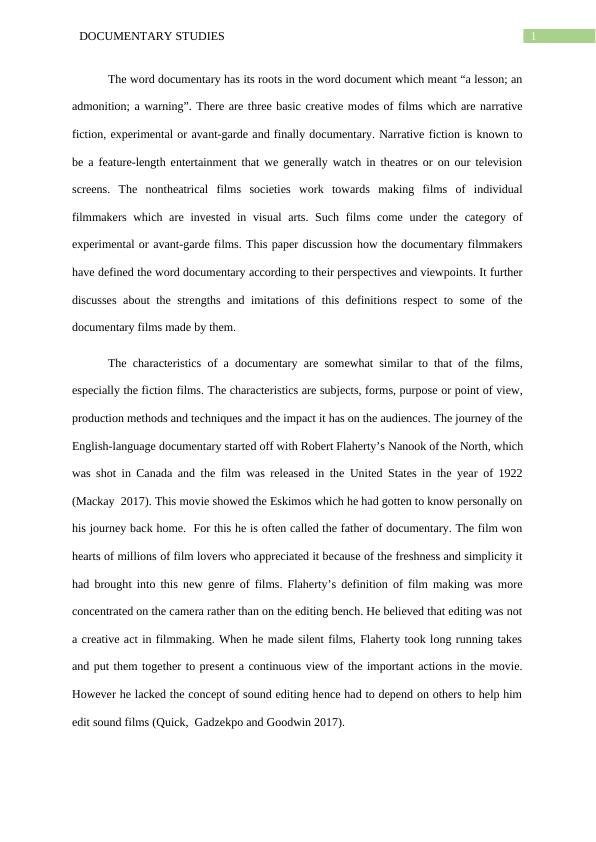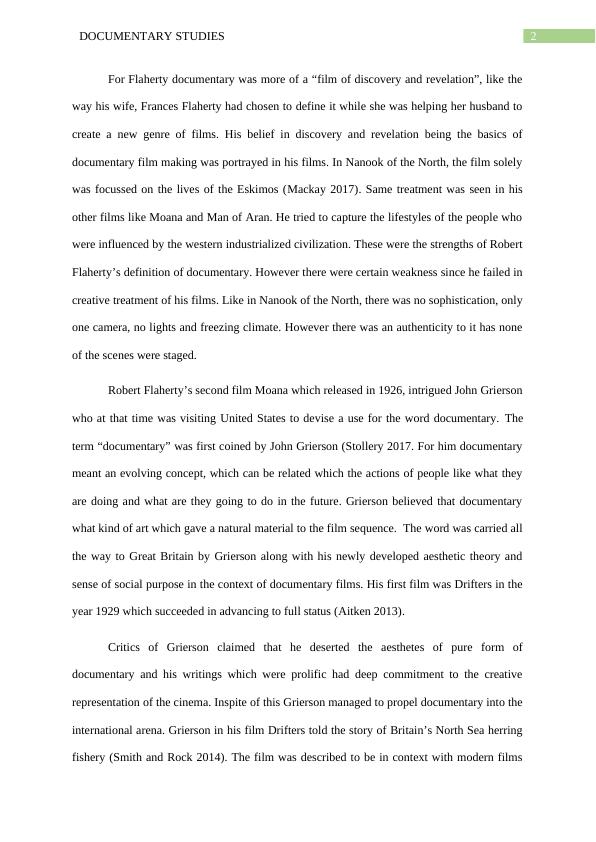Documentary Studies: Definition and Perspectives of Filmmakers
Added on 2023-06-11
8 Pages2080 Words265 Views
Running head: DOCUMENTARY STUDIES
DOCUMENTARY STUDIES
Name of the Student:
Name of the University:
Author Note:
DOCUMENTARY STUDIES
Name of the Student:
Name of the University:
Author Note:

1DOCUMENTARY STUDIES
The word documentary has its roots in the word document which meant “a lesson; an
admonition; a warning”. There are three basic creative modes of films which are narrative
fiction, experimental or avant-garde and finally documentary. Narrative fiction is known to
be a feature-length entertainment that we generally watch in theatres or on our television
screens. The nontheatrical films societies work towards making films of individual
filmmakers which are invested in visual arts. Such films come under the category of
experimental or avant-garde films. This paper discussion how the documentary filmmakers
have defined the word documentary according to their perspectives and viewpoints. It further
discusses about the strengths and imitations of this definitions respect to some of the
documentary films made by them.
The characteristics of a documentary are somewhat similar to that of the films,
especially the fiction films. The characteristics are subjects, forms, purpose or point of view,
production methods and techniques and the impact it has on the audiences. The journey of the
English-language documentary started off with Robert Flaherty’s Nanook of the North, which
was shot in Canada and the film was released in the United States in the year of 1922
(Mackay 2017). This movie showed the Eskimos which he had gotten to know personally on
his journey back home. For this he is often called the father of documentary. The film won
hearts of millions of film lovers who appreciated it because of the freshness and simplicity it
had brought into this new genre of films. Flaherty’s definition of film making was more
concentrated on the camera rather than on the editing bench. He believed that editing was not
a creative act in filmmaking. When he made silent films, Flaherty took long running takes
and put them together to present a continuous view of the important actions in the movie.
However he lacked the concept of sound editing hence had to depend on others to help him
edit sound films (Quick, Gadzekpo and Goodwin 2017).
The word documentary has its roots in the word document which meant “a lesson; an
admonition; a warning”. There are three basic creative modes of films which are narrative
fiction, experimental or avant-garde and finally documentary. Narrative fiction is known to
be a feature-length entertainment that we generally watch in theatres or on our television
screens. The nontheatrical films societies work towards making films of individual
filmmakers which are invested in visual arts. Such films come under the category of
experimental or avant-garde films. This paper discussion how the documentary filmmakers
have defined the word documentary according to their perspectives and viewpoints. It further
discusses about the strengths and imitations of this definitions respect to some of the
documentary films made by them.
The characteristics of a documentary are somewhat similar to that of the films,
especially the fiction films. The characteristics are subjects, forms, purpose or point of view,
production methods and techniques and the impact it has on the audiences. The journey of the
English-language documentary started off with Robert Flaherty’s Nanook of the North, which
was shot in Canada and the film was released in the United States in the year of 1922
(Mackay 2017). This movie showed the Eskimos which he had gotten to know personally on
his journey back home. For this he is often called the father of documentary. The film won
hearts of millions of film lovers who appreciated it because of the freshness and simplicity it
had brought into this new genre of films. Flaherty’s definition of film making was more
concentrated on the camera rather than on the editing bench. He believed that editing was not
a creative act in filmmaking. When he made silent films, Flaherty took long running takes
and put them together to present a continuous view of the important actions in the movie.
However he lacked the concept of sound editing hence had to depend on others to help him
edit sound films (Quick, Gadzekpo and Goodwin 2017).

2DOCUMENTARY STUDIES
For Flaherty documentary was more of a “film of discovery and revelation”, like the
way his wife, Frances Flaherty had chosen to define it while she was helping her husband to
create a new genre of films. His belief in discovery and revelation being the basics of
documentary film making was portrayed in his films. In Nanook of the North, the film solely
was focussed on the lives of the Eskimos (Mackay 2017). Same treatment was seen in his
other films like Moana and Man of Aran. He tried to capture the lifestyles of the people who
were influenced by the western industrialized civilization. These were the strengths of Robert
Flaherty’s definition of documentary. However there were certain weakness since he failed in
creative treatment of his films. Like in Nanook of the North, there was no sophistication, only
one camera, no lights and freezing climate. However there was an authenticity to it has none
of the scenes were staged.
Robert Flaherty’s second film Moana which released in 1926, intrigued John Grierson
who at that time was visiting United States to devise a use for the word documentary. The
term “documentary” was first coined by John Grierson (Stollery 2017. For him documentary
meant an evolving concept, which can be related which the actions of people like what they
are doing and what are they going to do in the future. Grierson believed that documentary
what kind of art which gave a natural material to the film sequence. The word was carried all
the way to Great Britain by Grierson along with his newly developed aesthetic theory and
sense of social purpose in the context of documentary films. His first film was Drifters in the
year 1929 which succeeded in advancing to full status (Aitken 2013).
Critics of Grierson claimed that he deserted the aesthetes of pure form of
documentary and his writings which were prolific had deep commitment to the creative
representation of the cinema. Inspite of this Grierson managed to propel documentary into the
international arena. Grierson in his film Drifters told the story of Britain’s North Sea herring
fishery (Smith and Rock 2014). The film was described to be in context with modern films
For Flaherty documentary was more of a “film of discovery and revelation”, like the
way his wife, Frances Flaherty had chosen to define it while she was helping her husband to
create a new genre of films. His belief in discovery and revelation being the basics of
documentary film making was portrayed in his films. In Nanook of the North, the film solely
was focussed on the lives of the Eskimos (Mackay 2017). Same treatment was seen in his
other films like Moana and Man of Aran. He tried to capture the lifestyles of the people who
were influenced by the western industrialized civilization. These were the strengths of Robert
Flaherty’s definition of documentary. However there were certain weakness since he failed in
creative treatment of his films. Like in Nanook of the North, there was no sophistication, only
one camera, no lights and freezing climate. However there was an authenticity to it has none
of the scenes were staged.
Robert Flaherty’s second film Moana which released in 1926, intrigued John Grierson
who at that time was visiting United States to devise a use for the word documentary. The
term “documentary” was first coined by John Grierson (Stollery 2017. For him documentary
meant an evolving concept, which can be related which the actions of people like what they
are doing and what are they going to do in the future. Grierson believed that documentary
what kind of art which gave a natural material to the film sequence. The word was carried all
the way to Great Britain by Grierson along with his newly developed aesthetic theory and
sense of social purpose in the context of documentary films. His first film was Drifters in the
year 1929 which succeeded in advancing to full status (Aitken 2013).
Critics of Grierson claimed that he deserted the aesthetes of pure form of
documentary and his writings which were prolific had deep commitment to the creative
representation of the cinema. Inspite of this Grierson managed to propel documentary into the
international arena. Grierson in his film Drifters told the story of Britain’s North Sea herring
fishery (Smith and Rock 2014). The film was described to be in context with modern films

End of preview
Want to access all the pages? Upload your documents or become a member.
